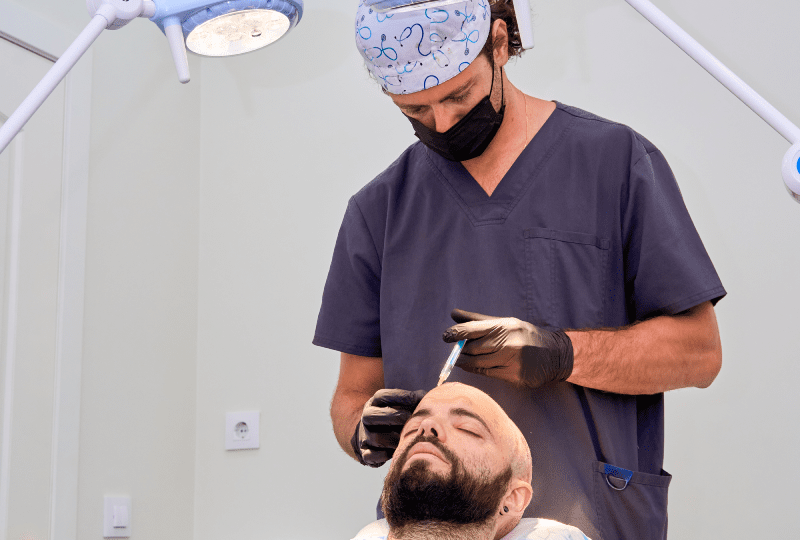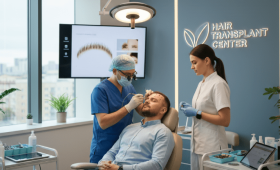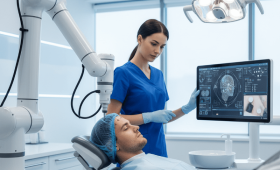How Does The Initial Consultation And Hair Analysis Process Work?
The initial consultation at hair transplant centers in Marmaris usually begins with a detailed hair and scalp analysis. In this analysis, the type of hair loss (Norwood scale), donor area density, and graft quality are determined. The patient’s expectations are listened to, and it is assessed how realistic these expectations are from a medical and aesthetic perspective. In light of this data, the necessary number of grafts for transplantation, the technique to be applied (FUE, DHI), and most importantly, the design of the natural-looking hairline are determined. This stage forms the foundation for a successful outcome.
What Tests Should Be Done Before Hair Transplantation?
Since hair transplantation is a surgical procedure, standard medical tests are performed before the operation to check the patient’s general health condition. These tests generally include screening for infectious diseases such as Hepatitis B, Hepatitis C, HIV, and basic biochemistry tests such as blood clotting time and complete blood count. These tests are necessary to minimize the risk of complications during and after the operation. Patients whose test results are not normal may be directed to relevant specialization areas before transplantation.
What Alternatives Are Offered If The Donor Area Is Insufficient?
If the donor area on the patient’s scalp (usually the nape) has an insufficient number of grafts or is very sparse, some specialized centers in Marmaris may consider the option of using body hair (chest, back, or beard area). This is known as BHT (Body Hair Transplant). Although body hairs are generally not as long-lasting and thick as scalp hair, they can be used as support, especially to provide density in the crown area. However, these alternatives are only offered as a last resort after the donor area potential has been carefully evaluated.
Why Is Hairline Design So Important?
Hairline design is the most critical step determining the aesthetic success of a hair transplant. A correctly designed line ensures that the transplant looks completely natural and is suitable for the person’s facial features. Experienced teams in Marmaris take into account the patient’s age, forehead muscle movement, and facial symmetry to design a personalized, slightly irregular, and soft transition front line. An artificial and straight line can cause the transplant to look unsuccessful, making this stage the most attentive and artistic aspect of the operation.
Why Should Smoking And Alcohol Be Quit Before Transplantation?
It is vital to quit smoking and alcohol consumption before and after a hair transplant. Smoking severely impairs the blood circulation critical for graft nourishment due to the nicotine it contains, reducing the graft survival rate. Alcohol, on the other hand, thins the blood, increasing the risk of bleeding and swelling during and after the operation. For successful healing and a high graft survival rate, these substances must be strictly avoided for at least one week before and one month after the operation.
What Is The Maximum Number Of Grafts That Can Be Transplanted In A Single Session?
The maximum number of grafts that can be transplanted in a single session depends entirely on the patient’s donor area capacity and scalp elasticity. Specialized teams in Marmaris generally manage to transplant between 4000 and 5500 grafts in one go without damaging the donor area. This limit is set to preserve the aesthetic integrity of the donor area and prevent permanent thinning due to over-harvesting. An expert analysis aims to achieve the highest yield without risking the patient’s health.
What Is The Anesthesia Method During Hair Transplantation?
In hair transplant operations in Marmaris, local anesthesia is generally used. This means the patient is awake during the procedure but feels no pain in the recipient and donor areas. In recent years, some centers have also offered the sedation option to enhance the effect of local anesthesia and ensure patients with needle phobia are relaxed. Sedation gently puts the patient into a twilight state, reducing anxiety and making the operation much more comfortable. The anesthesia option is determined based on the patient’s health status and preferences.
How Does The Graft Extraction Process Affect The Donor Area?
The graft extraction procedure (FUE or DHI) leaves scars in the donor area (usually the nape) in the form of very small, millimeter-sized holes. Modern techniques ensure these marks are nearly invisible, and when the healing process is complete (usually 10–14 days), the area returns to its completely natural appearance. Specialized teams in Marmaris attach great importance to preventing excessive thinning in the donor area by harvesting grafts homogenously and scattered. This careful approach ensures the aesthetic preservation of the region.
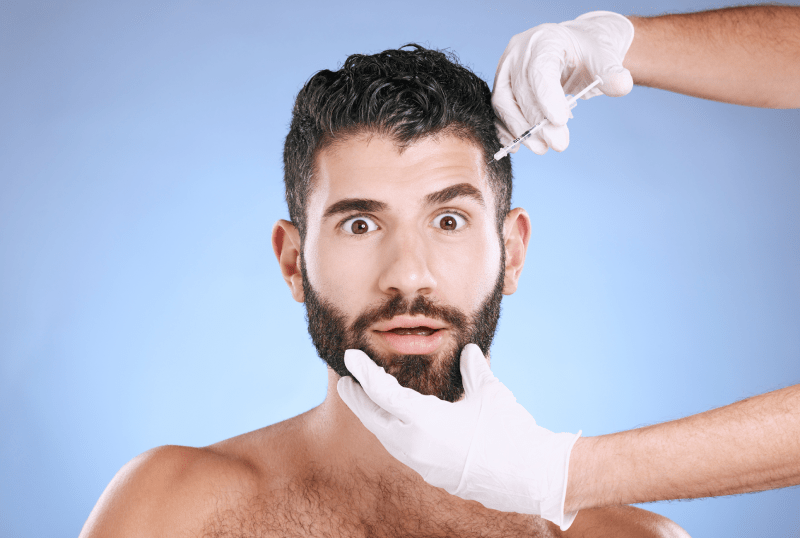
Why Is The Canal Opening Process Critical For Success?
The canal opening (Slit) process is the most critical technical stage for the natural growth of transplanted hair follicles and a high survival rate. The canals are the slots where the grafts will be placed and must be opened at the correct depth, angle, and direction. Leading centers in Marmaris use Sapphire or metal blades to perfectly match the canal opening angle to the patient’s natural hair growth direction (typically 30-45 degrees). Incorrectly opened canals can cause hair to grow unnaturally, stiffly, or in the wrong direction, leading to a failed transplant.
What Is The Fundamental Difference Between DHI And FUE Techniques?
The fundamental difference between DHI (Direct Hair Implantation) and FUE (Follicular Unit Extraction) is the method of graft placement. In FUE, grafts are collected, then canals are opened, and the grafts are placed into these canals. In DHI, a special Choi Implanter Pen is used; this pen holds the graft and directly implants it, setting the angle and depth simultaneously. DHI offers the advantages of less trauma, denser implantation, and a shorter out-of-body time for the roots, which makes it a preferred method in many Marmaris centers.
How Is The Viability Of Hair Follicles Preserved?
The time hair follicles (grafts) remain viable outside the body directly affects the success rate. Reliable centers in Marmaris apply special protocols to minimize this period. Grafts are immediately kept in special, cold, and nourishing solutions (e.g., HypoThermosol) after collection. These solutions slow down the metabolism of the roots, preventing cell damage and preserving their viability. Expert teams also run the graft extraction and implantation stages quickly and synchronously, limiting the duration the roots spend outside the body.
How Is Bleeding Controlled During Transplantation?
Bleeding control during hair transplantation is of great importance for the success of the operation and patient safety. Bleeding both restricts the field of vision, making it difficult for the team to work, and can negatively affect the graft survival. Centers in Marmaris use vasoconstrictor (vessel constricting) agents added to the local anesthesia solution to minimize bleeding. Additionally, the patient strictly avoiding blood thinners, alcohol, and smoking before the operation plays a critical role in bleeding control.
Can The Donor Area Be Preserved For Repeat Hair Transplants?
Yes, experienced teams in Marmaris adopt a special strategy to protect the donor area, considering the possibility of a future second or third transplant need. This strategy involves harvesting grafts by spreading them homogenously across the entire donor area instead of taking excessive grafts from a single region. In this way, the donor area does not look sparse even after the first transplant, and sufficient healthy graft reserve is left for future sessions. This approach is critical for a long-term and aesthetically sustainable outcome.
Is Painless Hair Transplantation Possible?
Thanks to evolving technology, modern hair transplant centers in Marmaris can offer an almost painless operation experience. Most of the pain is felt during the local anesthesia injections. To alleviate this initial discomfort, many centers offer needle-free injection devices or the option of sedation. Sedation ensures the patient is completely relaxed and comfortable throughout the operation, minimizing pain and anxiety. This provides great comfort, especially for patients with needle phobia or sensitive skin.
What Should Be Considered During The First Three Days After Transplantation?
The first three days after transplantation are the most critical period for graft adherence. Patients must sleep on their backs and in an elevated position, which helps reduce swelling (edema). The recipient area must not be touched, scratched, or subjected to trauma. Sweating and heavy physical activities should be avoided. Centers in Marmaris provide detailed care kits and instructions for this critical period, ensuring patients protect their grafts.
When Does Shock Loss Begin And How Long Does It Last?
Shock loss is a natural process that usually continues from the 2nd week to the end of the 3rd month after transplantation. This is the shedding of the transplanted hair shafts (not the roots) as they enter the resting phase in response to trauma. Patients should not worry about this temporary shedding because the roots remain intact and begin to grow new, permanent hairs after about 4–6 months. Expert teams in Marmaris inform patients about this process in detail beforehand to reduce anxiety.
How Do Sun And Seawater Affect Grafts After Transplantation?
After transplantation, sun and seawater pose potential dangers to the grafts. Direct sunlight can cause permanent pigmentation (spots) on the sensitive skin, and excessive heat can increase inflammation. Seawater, due to its salt and microorganisms, can cause infection or irritation in the transplant area. Therefore, patients vacationing in Marmaris must protect the transplant area with a hat for the first 1–2 months after the operation and strictly avoid swimming in the pool or sea.
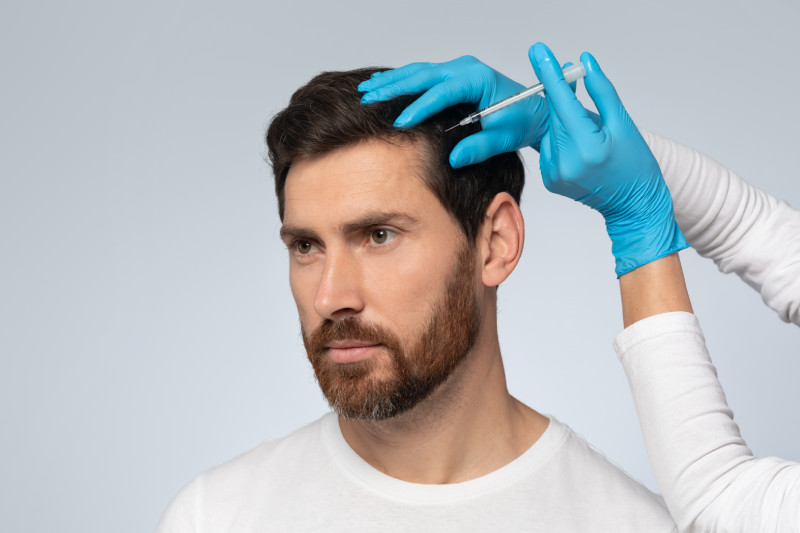
When Can Hair Be Normally Shaved And Dyed?
It takes time for the transplanted hair and donor area to fully heal and strengthen. Patients can usually apply scissors to the recipient area 1 month after the operation. However, it is recommended to wait 6 months before using a razor or electric shaver. Hair dyeing procedures can be performed starting from the 6th month to prevent the scalp from reacting to chemicals and to allow the roots to fully strengthen. Specialists in Marmaris provide definitive timelines for these processes to guarantee hair health.
Is Transplanted Hair Permanent And How Long Does It Last?
Since the transplanted hair follicles are taken from the nape area (donor area), which is genetically resistant to shedding, they are permanent for a lifetime in their new location. These roots are not sensitive to the DHT hormone that causes male pattern baldness. Thus, the hair that grows after a successful operation is resistant to shedding. However, since the surrounding native hair (not transplanted) may continue to shed, specialists may recommend medical support treatments (PRP, Minoxidil, etc.) to maintain long-term success.
What Does The Post-operative Care Kit Include?
Hair transplant centers in Marmaris provide a comprehensive post-operative care kit to enable patients to perform proper care at home. This set usually includes a special shampoo for gentle cleaning of the recipient area, a moisturizing lotion or foam, vitamin and mineral supplements to support graft health, as well as antibiotics and pain relievers. Additionally, a special neck pillow to ensure the patient sleeps in the correct position during the first few days may also be part of this set.
Is Revision Transplantation Possible In Case Of Failure?
In the event that a hair transplant fails due to a technical reason (e.g., low survival rate, incorrect hairline), revision transplantation (correction surgery) can be performed by specialist centers in Marmaris. Revision is planned after at least 12 to 18 months have passed since the first transplant, with careful analysis of the donor area’s potential. The goal is to correct aesthetic errors, increase density, and achieve a natural result that meets the patient’s expectations. Revisions are delicate procedures requiring high specialization.
When Is The Final Hair Transplant Result Seen?
The final and complete results of the hair transplant operation are usually seen 12 to 18 months later, as the hair follicles fully mature and thicken. While the hair that grows in the first 6 months may be thin, the hair begins to strengthen and gain volume after this period. Although expert teams in Marmaris conduct a general evaluation at the 12th month, waiting until the 18th month for the final result is a realistic approach, and patience during this process is crucial.
How Is Long-Term Follow-Up Performed After Hair Transplantation?
Quality hair transplant centers in Marmaris offer long-term and continuous follow-up service after the operation. This follow-up is generally conducted via phone, email, or video call at specific intervals (3rd, 6th, 12th, and 18th months). Patients send updated photos of their hair condition, and the team evaluates the healing process. This long-term follow-up ensures that potential problems are diagnosed early and that patient satisfaction is maintained at the highest level.
Can Measures Be Taken Against Future Hair Loss?
While the hair implanted through transplantation is permanent, there is a risk that other existing hair will continue to shed genetically. Specialists in Marmaris assess the patient’s overall shedding pattern and recommend necessary preventive measures to address this risk. These measures usually include medical treatments such as Minoxidil or Finasteride, which slow down shedding and strengthen existing hair, or regular PRP sessions. Adherence to the plan to protect existing hair after transplantation is essential for long-term success.
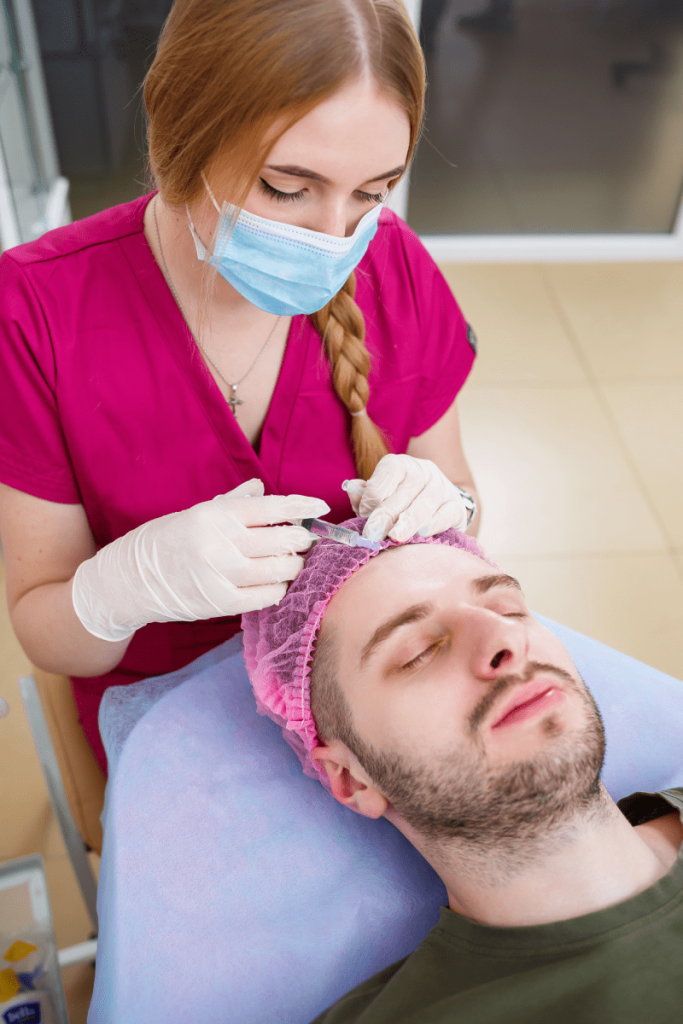
What Do Hair Transplant Packages Generally Include?
The comprehensive packages offered by hair transplant centers in Marmaris usually include many services beyond the cost of the operation. These packages often cover pre-operation tests and analyses, the operation itself (including the maximum number of grafts), post-operative medications and care kits, supportive treatments like PRP or mesotherapy, accommodation (hotel or private villa), and airport transfers as logistical services. The content of the packages aims to maximize the patient’s comfort and convenience.
What Are The Accommodation And Transfer Services Like In Marmaris?
Thanks to its developed tourism infrastructure, Marmaris offers high-comfort accommodation and transfer services to hair transplant patients. Most hair transplant packages include several nights of accommodation at luxury hotels contracted with the hospital or private villa options. Transfers between the airport (usually Dalaman Airport – DLM) and the hospital and hotel are provided with private VIP vehicles. These services guarantee that international patients, in particular, do not experience any logistical stress throughout their treatment process.
What Factors Affect The Cost Of Hair Transplantation?
The main factors affecting the cost of hair transplantation in Marmaris are the technique to be applied (DHI is generally more expensive than FUE), the number of grafts to be transplanted, the experience of the team performing the operation, the quality of the center where the operation is performed (hospital or clinic), and the scope of the package content (whether accommodation, transfer, PRP are included). Since personalized treatment plans are offered, a detailed consultation with the center is the most accurate approach for obtaining clear cost information.
Are Supportive Treatments Like PRP And Mesotherapy Included In The Price?
Many comprehensive hair transplant packages in Marmaris include supportive treatments such as PRP (Platelet-Rich Plasma) or hair mesotherapy in the price, aimed at strengthening hair follicles and accelerating healing. PRP is the process of injecting growth factors derived from the person’s own blood into the scalp. The inclusion of these treatments in the package should be seen as an advantage aimed at improving the patient’s overall hair health and the final success of the transplant.
What Are The Payment Options For Hair Transplantation?
Hair transplant centers in Marmaris offer various payment options to facilitate convenience for international patients. Payment can usually be made with cash (Euro, Dollar, or Turkish Lira) or bank card/credit card. Some centers may also accept wire transfers or cryptocurrency payment options, especially for patients coming from abroad. Payment plans and details should be clarified with the patient coordinator during the booking phase.
Is There A Guarantee Or Contract For The Possibility Of Revision?
Reliable hair transplant centers generally offer a guarantee or contract assurance for the success of the operation under certain conditions. This guarantee usually includes free revision, to the extent permitted by the donor area’s potential, if a certain percentage of the transplanted grafts (e.g., 80%) fail to survive. For the guarantee conditions to be valid, the patient is expected to have strictly followed post-operative instructions such as smoking, alcohol prohibition, and medication use. Contract details should be carefully reviewed before the operation.
Is Assistance Provided Regarding Transportation And Visa Procedures?
For patients coming to Marmaris from abroad, hair transplant centers usually offer guidance services regarding travel and visa procedures. Thanks to Turkey’s special regulations within the scope of health tourism, visits for treatment purposes may provide some conveniences. The centers’ patient coordinators help make the patients’ travel process as smooth as possible by finding the most suitable flights, arranging accommodation, and providing guidance on necessary visa documents.
Why Is Marmaris A Popular Region For Hair Transplantation?
Marmaris is not only a vacation paradise but also a popular choice for hair transplantation thanks to the high-standard medical tourism services it offers. Health institutions in the region use the latest technology equipment and may have international accreditations. Patients can enjoy the unique Mediterranean climate and nature after completing their treatment processes. The developed tourist infrastructure provides great convenience to patients regarding accommodation, transportation, and language support. This integrated service approach makes Marmaris attractive in health tourism and is therefore among the top choices for many international patients.
Why Are Hair Transplant Prices More Affordable In Marmaris?
As is generally the case in Turkey, the main reason why hair transplant prices in Marmaris are more affordable compared to Europe and the United States is the difference in exchange rates. The value of the currencies of countries with high living standards against the Turkish Lira automatically lowers the cost of treatment. Furthermore, the high competition environment and state incentives in Turkey also help keep costs at reasonable levels. The affordability of prices does not mean sacrificing quality; on the contrary, patients can receive the same or higher quality service at a price that better suits their budget.
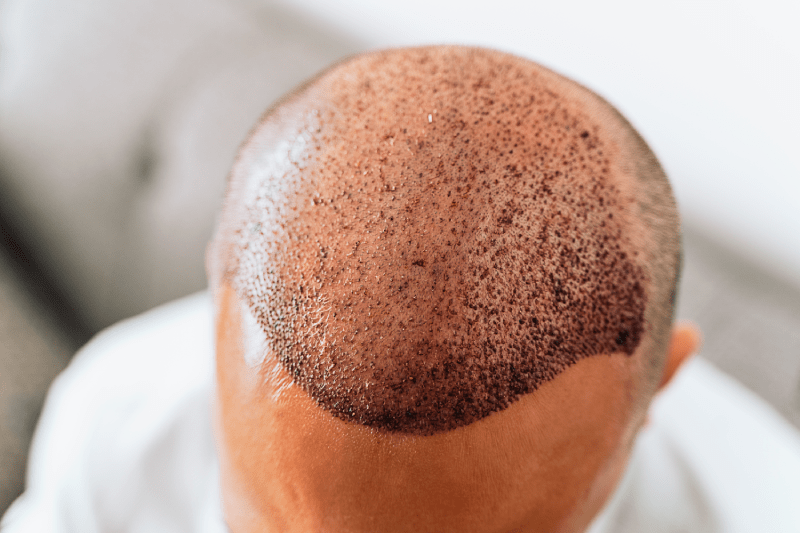
Do Hair Transplant Centers In Marmaris Comply With International Standards?
Many major health institutions and hair transplant centers in and around Marmaris provide services in compliance with international quality standards such as JCI (Joint Commission International). These centers undergo strict audits regarding sterilization, patient safety, the quality of equipment used, and post-operative follow-up processes. The application of modern techniques by experienced teams meets patients’ expectations for high success rates and a safe treatment process. Compliance with international standards is a great source of confidence for patients choosing Marmaris.
What Technologies Used In Hair Transplantation Are Available In Marmaris?
Modern hair transplant centers in Marmaris apply the most advanced methods brought by current technology. The foremost among these are the Sapphire FUE (Follicular Unit Extraction) and DHI (Direct Hair Implantation) techniques. Sapphire FUE allows for smaller channels to be opened, accelerating the healing process and minimizing scarring. The DHI method allows grafts to be directly implanted using a special pen, shortening the time roots spend outside the body and offering the possibility of denser implantation. The centers offer personalized solutions by determining the most suitable technique based on the patient’s hair structure and shedding condition.
What Is The Quality Of Language Support For Foreign Patients Coming To Marmaris?
Since Marmaris is an international tourist center, hair transplant centers in the region provide professional support in many languages, especially English, German, Russian, and Arabic. Translators and multilingual patient coordinators eliminate communication problems at every stage, from arranging patient appointments to pre-operative information and post-operative follow-up. This comprehensive language support guarantees that foreign patients feel safe and clearly understand the entire treatment process.
Can Patients Vacation In Marmaris Before And After Hair Transplantation?
One of Marmaris’s biggest advantages is that patients can combine their treatment processes with an enjoyable period of rest. One can take advantage of the region’s beauties to relax before the operation. After the critical first few days following the operation (usually 3-4 days later), patients can spend time along Marmaris’s coastline in relaxation mode, avoiding direct sun exposure or heavy physical activity. However, protection from the sun and seawater is vital for the health of the grafts; therefore, the specialist’s instructions must be strictly followed.
How Experienced Are The Hair Transplant Teams In Marmaris?
Hair transplant operations in the Marmaris region are generally performed by teams consisting of trained and certified healthcare professionals with long years of experience in this field. The prominence of the region in health tourism ensures that the teams have carried out hundreds, even thousands, of successful operations, both locally and internationally. Experience is a key factor for correct graft harvesting, natural hairline design, and a high graft survival rate. Patients are advised to thoroughly research the team’s operational experience and references.
Conclusion: Marmaris is a globally trusted center for hair transplantation due to its natural beauty, modern facilities, and expert teams. To make the best decisions on your hair transplant journey and experience all these processes safely and to international standards, we recommend contacting Cure Holiday, which offers personalized treatment plans and comprehensive packages. Experience the quality and comfort Turkey offers, all in one place!
